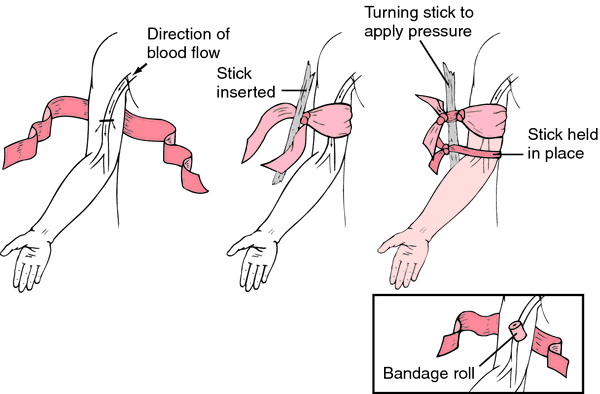tourniquet
Also found in: Dictionary, Thesaurus, Encyclopedia, Wikipedia.
tourniquet
[toor´nĭ-ket]
a device for compression of an artery or vein; uses include stopping of the excessive bleeding of a hemorrhage, maintenance of a nearly bloodless operative field, prevention of spread of snake venom after a snakebite, and aiding in obtaining blood samples or giving intravenous injections.
For hemorrhage, a tourniquet should be used only as a last resort, when the bleeding is so severe that it is threatening the life of the injured person and cannot be stopped by direct pressure. In the case of snakebite, a moderately tight tourniquet may be applied to impede the spread of venom while not stopping arterial blood flow. For an intravenous injection, a loosely applied tourniquet inhibits blood flow in the superficial veins, making them more prominent so that a vein can be found for the injection. For maintenance of a nearly bloodless operative field, pneumatic tourniquets are often used. The American Association of Operating Room Nurses (AORN) has published guidelines for the use of tourniquets during surgery; see their web site at http://www.aorn.org.

For hemorrhage, a tourniquet should be used only as a last resort, when the bleeding is so severe that it is threatening the life of the injured person and cannot be stopped by direct pressure. In the case of snakebite, a moderately tight tourniquet may be applied to impede the spread of venom while not stopping arterial blood flow. For an intravenous injection, a loosely applied tourniquet inhibits blood flow in the superficial veins, making them more prominent so that a vein can be found for the injection. For maintenance of a nearly bloodless operative field, pneumatic tourniquets are often used. The American Association of Operating Room Nurses (AORN) has published guidelines for the use of tourniquets during surgery; see their web site at http://www.aorn.org.

To apply a tourniquet for control of arterial bleeding from the arm: Wrap a gauze pad twice with a strip of cloth just below the armpit and tie with a half knot; tie a stick at the knot with a square knot. Slowly twist stick to tighten.
tourniquet test one involving the application of a tourniquet to a limb, as in determination of capillary fragility (denoted by the appearance of petechiae) or of the status of the collateral circulation.
Miller-Keane Encyclopedia and Dictionary of Medicine, Nursing, and Allied Health, Seventh Edition. © 2003 by Saunders, an imprint of Elsevier, Inc. All rights reserved.
tour·ni·quet
(tūr'ni-ket),
An instrument for temporarily arresting the flow of blood to or from a distal part by pressure applied with an encircling device.
[Fr. fr. tourner, to turn]
Farlex Partner Medical Dictionary © Farlex 2012
tourniquet
(to͝or′nĭ-kĭt, tûr′-)
n.
A device, typically a tightly encircling bandage, used to check bleeding by temporarily stopping the flow of blood through a large artery in a limb.
The American Heritage® Medical Dictionary Copyright © 2007, 2004 by Houghton Mifflin Company. Published by Houghton Mifflin Company. All rights reserved.
tourniquet
A cord or constrictive band used to ↓ blood flow to 1+ extremity; tourniquets have clinical currency in ↓ the centripetal flow of toxins in snake and scorpion bites, and in ↓ the cardiac load in acute CHF, as may occur in an acute MI, where the tourniquets are rotated, simultaneously with other emergency measures–eg, O2, lasix, nitroprusside, nitroglycerin; when used, a tourniquet should be confined to the proximal part of the extremity. See Rotating tourniquet.
McGraw-Hill Concise Dictionary of Modern Medicine. © 2002 by The McGraw-Hill Companies, Inc.
tour·ni·quet
(tŭr'ni-kĕt)
An instrument for temporarily arresting the flow of blood to or from a distal part by pressure applied with an encircling device.
[Fr. fr. tourner, to turn]
Medical Dictionary for the Health Professions and Nursing © Farlex 2012
tourniquet
An encircling band placed around a limb and tightened enough to compress blood vessels and prevent blood flow. Tourniquets are used in surgery or in the emergency control of severe bleeding from an artery or a large vein, but are dangerous if left in place for more than an hour or so. A forgotten tourniquet inevitably causes GANGRENE and loss of the limb beyond the point of application.
Collins Dictionary of Medicine © Robert M. Youngson 2004, 2005
Tourniquet
A device used to control bleeding, consisting of a constricting band applied tightly around a limb above the wound. It should only be used if the bleeding in life-threatening and can not be controlled by other means.
Mentioned in: Phlebotomy, Wounds
Gale Encyclopedia of Medicine. Copyright 2008 The Gale Group, Inc. All rights reserved.
tour·ni·quet
(tŭr'ni-kĕt)
An instrument for temporarily arresting the flow of blood to or from a distal part by pressure applied with an encircling device.
[Fr. fr. tourner, to turn]
Medical Dictionary for the Dental Professions © Farlex 2012